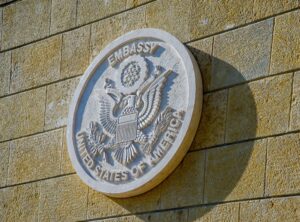Welsh Government issues 12-week consultation on short term action plan which seeks to reduce particulate matter in industrial area of South Wales, writes Caelia Quinault
An action plan to help improve air quality in the industrial town of Port Talbot has been published for consultation by the Welsh Government.
While air pollution in Wales has been improving in recent years, Port Talbot has historically had a high level of air pollution due to industry such as the steelworks and emissions derived from road transport.
Aerial photograph of the Neath Port Talbot county borough council Air Quality Management Area for Taibach/Margam outlined in redThe Clean Air for Port Talbot short term action plan, developed earlier this year (see airqualitynews.com story), lays out measures that can be taken, in addition to everyday activities, where there is a risk of particulate matter limit values being exceeded — particularly for particulate matter below 10 microns in diameter (PM10).
There should be no more than 35 days a year when daily average particulate matter exceeds European limits on air pollution.
The draft plan outlines a number of actions to be undertaken by the Welsh Government, Environment Agency Wales and Neath Port Talbot county borough council should limits be exceeded.
These might include: The regulation of the steelworks; on-site traffic control measures within the steelworks site (encompassing Tata Steel UK, Harsco and Tarmac); the introduction of traffic restrictions or speed limits on motorways and main roads; planning constraints; and, reducing industrial activity.
Unveiling the draft plan yesterday (November 6), Welsh Environment Minister, John Griffiths, said: “We are taking steps to deliver actions that make a difference to ordinary people, their families and communities.
“We are doing this by acting in the long term interests of the people of Wales, putting sustainable jobs and growth first but never losing sight of other factors that are vital to people’s long term quality of life. I encourage everyone living in the Port Talbot area to read our plan to improve air quality in their neighbourhood and to respond to this consultation.”
Comments received from the public and local interest groups during this consultation period will be used to develop a final plan. In 2013 a second public consultation on a revised plan will be carried out.
Related Links













Leave a Reply